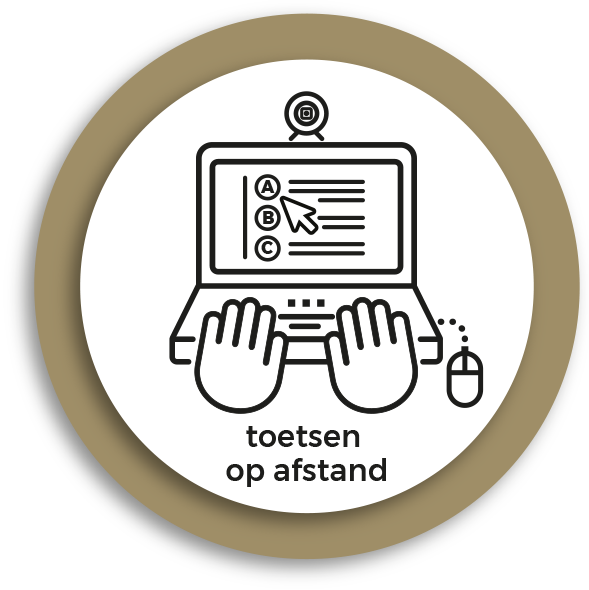Description
Often, you not only want to test knowledge, but its application too. This can be done in online exams, for example in the form of open-ended questions. Other options are open book exams or case study exams. Although these are less susceptible to cheating in their online form than exams with multiple choice questions alone, they are more labour-intensive. They are therefore more likely to be an option if you have help, such as a student assistant. This assessment method is therefore very suitable for use on a smaller scale.
Presentations, projects or products are often suitable for assessing application skills. Although presentations and interviews often take place face-to-face, they can also be carried out online using video conferencing software such as Zoom or Microsoft Teams. This saves travel time and costs for both students and examiners.
How
There are lots of options for the online assessment of application skills at the small scale. Select the form that best suits the learning objectives and the teaching provided.
Assessing presentations, projects or products can be very time-consuming, and may therefore not seem to be an obvious choice. However, their assessment can be made easier by dividing the students into groups. Peer feedback can then be implemented in a formative setting, so that students assess each other’s work. It may also help to have students record their presentations, so that you can assess them at a more suitable time and location.
Online assessment methods
Digital assessment
Click here for more information on digital assessment.
Tips for this assessment method * Use open-ended questions as much as possible, in random order.
*Live proctoring is quite feasible on a small scale.
- In the case of open-ended questions, set a limit on the number of words, for exaple, or what the answer should include, to prevent long-winded answers.
Presentations
Click here for more information on presentations.
Tips for this assessment method
Assessing presentations, projects or products can be very time-consuming, and may therefore not seem to be an obvious choice at this scale. However, the assessment in a formative setting can be made easier by dividing students into groups and/or implementing peer feedback, in which students assess one another’s work. It may also help to have students record their presentations, so that you can assess them at a more suitable time and location.
It may be a good idea to make video recordings. These can be reviewed later, for example if the examiner is still unsure of something, or by a second examiner. The student can also benefit from reviewing the recording, either on their own or together with an examiner, to reflect on their presentation or to discuss their assessment.
Divide the students into groups wherever possible so that they can give a group presentation, to reduce the time required for assessment.
In the case of formative assessment, use can be made of peer feedback.
Oral exams
Click here for more information on oral exams.
Tips for this assessment method
- Assessing presentations, projects or products can be very time-consuming, and may therefore not seem to be an obvious choice at this scale. However, the assessment in a formative setting can be made easier by dividing students into groups and/or implementing peer feedback, in which students assess one another’s work. It may also help to have students record their presentations, so that you can assess them at a more suitable time and location.
Observations
Click here for more information on observations.
Tips for this assessment method
- Assessing presentations, projects or products can be very time-consuming, and may therefore not seem to be an obvious choice at this scale. However, the assessment in a formative setting can be made easier by dividing students into groups and/or implementing peer feedback, in which students assess one another’s work. It may also help to have students record their presentations, so that you can assess them at a more suitable time and location.
Portfolio
Click here for more information on portfolios.
Projects and products
Click here for more information on projects and products.
Recommended assessment methods
Tips
Set a suitable time limit: too much time increases the risk of cheating, but too little time causes stress and reduces the validity of the exam results. See Van Berkel (1999) (in Dutch) for estimates of the time needed for different types of questions.
Emphasize the student’s ethical responsibility not to cheat.
Ensure good communication with the students.
- Be transparent about the online assessment process, so that students know what to expect. Let them know for example which personal details will be needed and what they will be used for, and what they need to have with them (e.g. a student card, telephone or camera).
- If online proctoring will be used, be clear about what the students can expect and what the rules are. Transparency about how the online proctoring will be implemented is essential. For more information, see the SURF online proctoring report: Surveilleren op afstand.
- You also need to let the students know about any technical requirements. At a minimum, students will need a stable internet connection. It is important to let the students know of any specific computer hardware requirements for the assessment software and to provide alternatives if this is not available.
Not every student has suitable living conditions with a quiet room to take an exam in. Where possible, offer an alternative, such as a room on campus that students can use.

